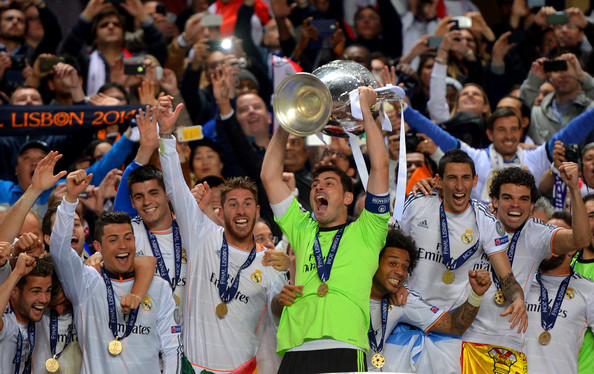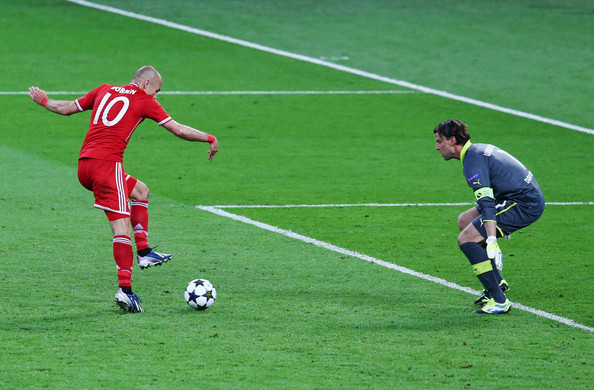Not many would have disagreed with Arsene Wenger. His observation seemed spot on, his assertion quite right on the money. For the 2013-2014 Champions League season, Bayern Munich were the favourites.
In fact, as Wenger aptly put it, they were the super favourites.
And that truly showed in the opening rounds — especially against Manchester City. At the Etihad Stadium, Bayern Munich out-passed and outplayed the Citizens. It seemed then as if the Bavarian club was on course to achieve the unachievable. Maybe, they could become the first club in the Champions League era to defend the European Cup.
But laboured wins against Arsenal and Manchester United in the knock out rounds brought about a sense of their vulnerability. In the end, the capitulation at the hands of Real Madrid brought their Champions League campaign to an end.
Throughout the tournament however — and especially at the start — the predictions were that they could win it.
The Era of Super Favourites
In a way, that was exactly how previous recent Champions League campaigns had been. From 2008 coming up to 2013, the early season predictions were that one team would in all probability clinch the trophy with big ears. Their status among the favourites being super — a notch higher, a step ahead of everyone else.
That era of super favourites now seems to have come to an end.
The 2014-2015 Champions League season begins with there being no single clear favourite. Whereas other seasons had first Barcelona, then Bayern Munich as the team to beat, this season sees a host of other teams join the fray.
It could point to how infinitely superior Barcelona and Bayern Munich were at their highest. Indeed, these two teams — especially the winners in 2011 and 2013 respectively — were spectacular enough to be considered among the pantheon of the greats. These teams were also a culmination of a glorious cycle of team squad and team style — for Barcelona from 2008 and for Bayern Munich from 2010.
Those points of escalation have surely dropped now. None of them are as fierce as they used to be, and despite the fact that they are still great teams, there is a sense that they are now beatable where once they used to be invincible.
In turn however, it could be that the Champions League’s ability to conjure up different eras is at work, with another era coming to an end and possibly a new one beginning.
The Eras of the Champions League
Certainly, the Champions League years can be divided into different eras. Between 1993 and 1998 was the Italian era, where Italian football dominated Europe. Then came the expansion of the tournament in 1998. With more games came a need for squad depth — probably explaining why the riches of Real Madrid dominated between 1998 and 2002.
In 2003 came an era of openness. The effects of expansion began to be felt, and thus it was not necessary for the Champions League winner to be the best team in Europe. Seemingly, any team could win it — such as Porto did in 2004 and Liverpool a year later. Consequently there was the peculiarity of a Milan side which dominated Europe during this period but could not do so in its domestic league.
Europe’s Golden Years
After that came what is the prime of period of European football in the competition’s history. Between 2008 and 2014, the Champions League winner was actually the best team in Europe. European champions were also champions of their domestic leagues, (with the exception of Chelsea in 2012 and Real Madrid last season) while there were three trebles in this period (there had been four in 52 years before 2009).
This graceful period may now be over.
In turn though, that era of dominance may give way to an era of competitiveness.
The factors dictating that are many, but one key one exist. While finances are rarely evenly spread, the induction of the Financial Fair Play rules may affect hugely how the Champions League develops.
Firstly, it will lock the most resourceful clubs at the top. As such, whereas spending will be limited, it is those with the money who will spend the most regardless.
Hierachy of Favourites
Therefore, this creates a so called hierarchy of favourites. At the top is around six or seven teams for whom spending has assured their status. Barcelona, Bayern Munich and Real Madrid, as well as PSG, Manchester City and Chelsea find themselves here.
Below them is a group of teams who may get close but will have to do even more if they are to become European champions. As much as their squads look illuminated, the likes of Borussia Dortmund, Atletico Madrid, Arsenal and Juventus have to dig very deep to pose a serious challenge.
Of course, this second tier is best explained by the manner in which the last two Champions League Finals have ended. Whereas Dortmund and Atletico started the Finals brightly, they were in the end undone in the last minute by either the determination of Sergio Ramos or the individual brilliance of Arjen Robben.
By then however, the might of Bayern and Madrid had already started showing. Their superiority was not in question and there was no argument as to who were the better side over the course of the game. This indicates at the slight but clear difference between the top tier and secondary tier.
Below the secondary tier is a group of teams fighting to get into the second tier (the likes of but not limited to Benfica, Porto, Monaco, Roma, Liverpool and Zenit) while there are teams who can only comprehend getting to the knockout rounds as significant success (APOEL Nicosia, RSC Anderlecht etc.).
The meat of the Champions League is however at the top, and this is where most of the quality and action (and money) is concentrated.
A New Era
What is most intriguing however is what the eventual consequences of FFP will be. Already during the past transfer window, some deals did not go through due to threat of these sanctions. Presumably, PSG did not acquire Angel Di Maria and Real Madrid baulked at the figures quoted by Falcao and his representatives.
It means that these two went to Manchester United — a team not in the Champions League this season. Indirectly, it does show what the paramount effect of FFP might be. Without the freedom to spend as increasingly as used to, teams will be weary.
That does not mean that spending will go lower (or rather, the perception of spending as Gabriel Marcotti argues). Instead though, the greatest players around the world will get distributed among various teams across Europe.
This may thus assure competitiveness in some sense. For that reason thus, the Champions League season of 2014-2015 may be the start of things. The era of super favourites is gone. But among the superclubs, there will be much jostling for Europe’s crown.




Interesting insight on the FFP, i had no idea how it works..now i know.Its actually a sigh of relief for most clubs who have the desire but no resource,it also kind fo ends one man teams